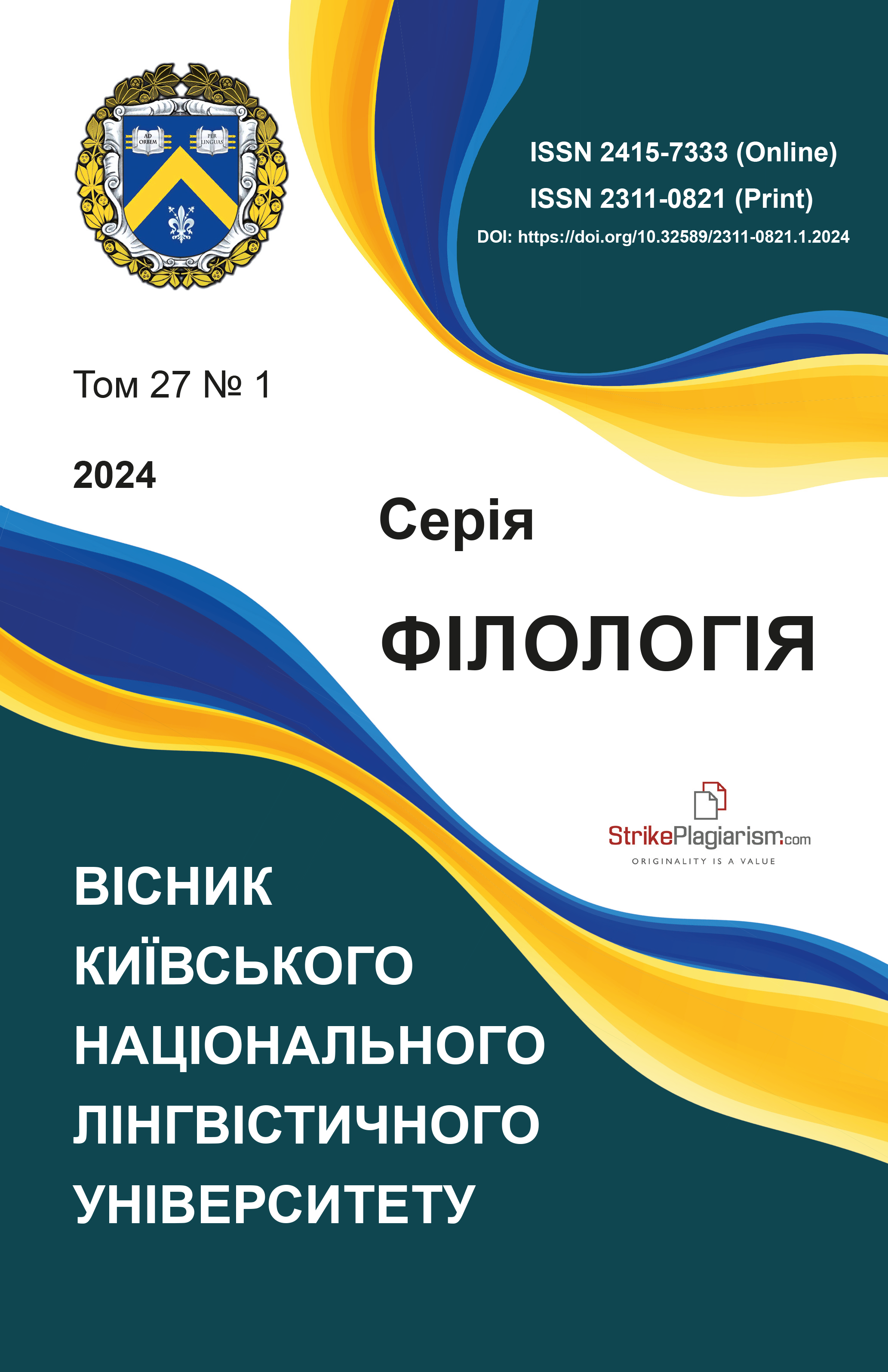Комічні скоромовки як культурно зумовлений розважальний засіб
DOI:
https://doi.org/10.32589/2311-0821.1.2024.309610Ключові слова:
скоромовка, гумор, німецька мова, комічні елементи, гумористична компетентністьАнотація
Cтаття присвячена вивченню німецьких скоромовок як особливих репрезентантів гумору та сміхової культури в німецькомовному комічному просторі. Дослідження спрямоване на вивчення лінгвокультурних аспектів німецьких скоромовок з метою відображення їхнього гумористичного та національно культурного потенціалу. Зважаючи на різні підходи до вивчення гумору, сміхової культури та комічного мовлення, визначено структурно-семантичні та прагматичні засоби, що використовуються в німецькомовних скоромовках для вираження комічного ефекту та позитивних емоцій, виявлено специфіку формування німецькомовного гумору крізь скоромовки, проаналізовано структурні та семантичні елементи німецькомовних скоромовок, які репрезентують сміхову культуру німецькомовного простору. Скоромовки визначають як веселі короткі оповідання, заплутані дивні вислови, нонсенс-тексти тощо, які прогнозують формування комічного ефекту крізь свої план змісту та план вираження. У плані
змісту скоромовок закладена гумористична гра, яка викликає емоційно-експресивне напруження та перетворює комунікацію в неофіційну. План вираження містить елементи, які прагматизують комічний ефект (паралелізм, повторення, алітерація тощо). Примітним є те, що для посилення комічного ефекту в скоромовках залучені модифіковані фразеологічні одиниці, які є ідентифікаторами пізнавальної діяльності людей цільової лінгвокультури. Скоромовки потребують адекватної вокальної репрезентації елементів тексту, провокують позитивні емоційні реакції, викликають сміх. У їх структурі візуалізуються національно-культурні елементи, які належать до фонових знань цільової лінгвокультури. При вимовлянні скоромовок із певним ритмом виникають ненавмисні обмовки, що також посилює комічний ефект. Національно-культурну специфіку скоромовок виявлено через позначення національностей, власних назв, національних страв і напоїв, професій.
Посилання
Awdiejejw, A. (1992). “Nieśmieszne aforyzmy. (Refleksja nad semantyką humoru Viktora
Raskina)”. Język a Kultura. t. 8, 279–285.
Buttler, D. (2001). Polski dowcip językowy. PWN, 52–53.
Dornaus, Ch. (2016). Humor als Förderfaktor für Innovationen. University of Bamberg
Press.
Dziemidok, B. (1967). O komizmie. Książka i Wiedza.
Каневська, О. Б. (2014). Порівняльна характеристика українських і російських
скоромовок. Літератури світу: поетика, ментальність і духовність, 4, 137–149.
Кіліченко, Л. М. (1979). Українська дитяча література. Вища школа.
Kotthoff, H. (1997). “Erzählstile von mündlichen Witzen: Zur Erzielung von Komikeffekten
durch Dialoginszenierungen und die Stilisierung sozialer Typen im Witz”. Sprech-
Gesprächsstile. Hrsg. Margaret Selting und Barbara Sandig. De Gruyter, 123–170.
Löschmann, M. (2015). [Hrsg.]: Humor im Fremdsprachenunterricht. Deutsch als
Fremdsprache in der Diskussion, 10 Frankfurt. Lang, 9‒58.
https://www.pedocs.de/volltexte/2017/12862/pdf/Loeschmann_2015_Humor_muss_
sein.pdf
Müller, R. (2003). Theorie der Pointe. Mentis Verlag.
Nevo, O. A., Klingman, H. A. (1998). The development and evaluation of a systematic
program for improving sense of humor. In: W. Ruch (Ed): The sense of humor:
Explorations of a Personality Characteristics. Mouton de Gruypter, 385–404.
Röhrich, L. (2003). Lexikon der sprichwörtlichen Redensarten. Freiburg. Basel. Wien.
Sieglinde, E., Hinderer M. (2014). Stimm- und Sprechtraining für den Unterricht.
Schöningh.
Wiedenmann, N. (1999). Versprecher: Dissimilation von Konsonanten. Niemeyer.
Winter, G. (2007). Zungenbrecher. Wenn Papa Grappa schlabbert … und andere
Stolperverse. GGP Media GmbH, Pößneck.
Wowro, I. (2021). Das Phänomen auf der Zunge. Zu Spezifik und Humorindikatoren der
Zungenbrecher. Linguistische Treffen in Wrocław, 19, (I).
https://doi.org/10.23817/lingtreff.19-21.
Wowro, I. (2011). “Nie solo sein”, “Rum am Amur” oder ‚Zagwiżdż i w gaz’. Formale
und semantische Typenvielfalt von polnischen und deutschen Palindromen”. Studia
Niemcoznawcze/ Studien zur Deutschkunde, 48, 457–477.
##submission.downloads##
Опубліковано
Номер
Розділ
Ліцензія
1. Дослідження, що публікуються у збірнику наукових праць, повинні бути виконані відповідно до чинного законодавства України та етичних норм. Основний обов’язок автора полягає в тому, щоб виконати таке дослідження, яке заслуговує на об’єктивне обговорення науковою спільнотою його значущості.
2. Автори повинні формулювати свої наукові спостереження у такий спосіб, щоб їхні результати могли бути підтверджені іншими вченими, без підробки отриманих висновків або маніпуляції ними.
3. Автори статей несуть відповідальність за зміст статей і за сам факт їх публікації.
4. Автор повинен цитувати ті публікації, які вплинули на сутність роботи, а також ті, які можуть швидко познайомити читача з попередніми роботами, важливими для розуміння цього дослідження. За винятком оглядів, слід мінімізувати цитування робіт, які не мають безпосереднього відношення до змісту дослідження. Автор зобов’язаний провести джерельний пошук, щоб знайти і процитувати оригінальні публікації, тісно пов’язані з цим матеріалом. Необхідно також коректно вказувати на джерела принципово важливих матеріалів, використаних у цій роботі, якщо вони не були отримані самим автором.
5. Автори повинні дотримуватися усіх чинних вимог щодо публікацій рукописів. Неприпустимим є плагіат та його удавання за оригінальну розвідку, а також подання до редакції раніше опублікованої статті. У випадках виявлення плагіату відповідальність несуть автори поданих матеріалів.
6. Експериментальне або теоретичне дослідження може іноді слугувати основою для науково коректної і об’єктивної критики роботи іншого дослідника. Опубліковані статті в окремих випадках можуть містити подібну критику. Персональна суб’єктивна критика не є доречною за жодних обставин.
7. Співавторами статті мають бути ті особи, науковий внесок яких є вагомим у її зміст та які розділяють відповідальність за здобуті результати. Автор, який подає рукопис до друку, відповідає за те, щоб до списку співавторів були включені всі ті й лише ті особи, які відповідають критеріям авторства. У статті, написаної декількома авторами, той з авторів, хто подає до редакції контактні відомості, документи і листується з редакторами, бере на себе відповідальність за згоду інших авторів статті на її публікацію у збірнику.
8. Автори повинні повідомити редактора про будь-який потенційний конфлікт інтересів, на які могла б вплинути публікація результатів, що містяться у рукописі.
9. Автори повинні чітко вказати джерела всієї процитованої інформації, оформити посилання на наукові джерела відповідно до вимог ДСТУ ГОСТ 7.1:2006.
10. Редколегія має право відмовити у публікації статті за умов недотримання зазначених вимог.
11. Автор може висловити побажання не залучати деяких рецензентів до розгляду рукопису. Проте головний редактор може прийняти рішення залучити одного або декількох із цих рецензентів, якщо переконаний, що їх думки є важливими для неупередженого розгляду рукопису. Таке рішення може бути прийняте, наприклад, у тому випадку, коли є серйозні суперечності між цим рукописом і попередньою роботою потенційного рецензента.
12. Запобігання псевдонауковим публікаціям є відповідальністю кожного автора, головного редактора, рецензента, видавця й організації.


